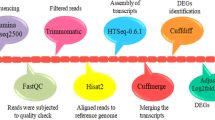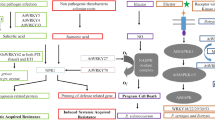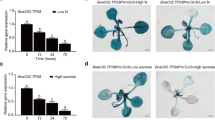Abstract
Key message
Based on Arabidopsis microarray, we found 8 WRKY genes were up-regulated with Oxalic acid (OA) challenge, AtWRKY28 and AtWRKY75 overexpression lines showed enhanced resistance to OA and Sclerotinia sclerotiorum.
Abstract
The WRKY transcription factors are involved in various plant physiological processes and most remarkably in coping with diverse biotic and abiotic stresses. Oxalic acid (OA) is an important pathogenicity-determinant of necrotrophic phytopathogenic fungi, such as Sclerotina sclerotiorum (S. sclerotiorum) and Botrytis cinerea (B. cinerea). The identification of differentially expressed genes under OA stress should facilitate our understanding of the pathogenesis mechanism of OA-producing fungi in host plants, and the mechanism of how plants respond to OA and pathogen infection. Based on Arabidopsis oligo microarray, we found 8 WRKY genes that were up-regulated upon OA challenge. The Arabidopsis plants overexpressing AtWRKY28 and AtWRK75 showed enhanced resistance to OA and S. sclerotiorum simultaneously. Furthermore, our results showed that overexpression of AtWRKY28 and AtWRK75 induced oxidative burst in host plants, which suppressed the hyphal growth of S. sclerotiorum, and consequently inhibited fungal infection. Gene expression profiling indicates that both AtWRKY28 and AtWRKY75 are transcriptional regulators of salicylic acid (SA)- and jasmonic acid/ethylene (JA/ET)-dependent defense signaling pathways, AtWRKY28 and AtWRKY75 mainly active JA/ET pathway to defend Arabidopsis against S. sclerotiorum and oxalic acid stress.






Similar content being viewed by others
References
Boland GJ, Hall R (1994) Index of plant hosts of Sclerotinia sclerotiorum. Can J Plant Pathol 16:93–100
Bolton MD, Thomma BPHJ, Nelson BD (2006) Sclerotinia sclerotiorum (Lib.) de Bary: biology and molecular traits of a cosmopolitan pathogen. Mol Plant Pathol 7:1–16
Brand LH, Kirchler T, Hummel S, Chaban C, Wanke D (2010) DPI-ELISA: a fast and versatile method to specify the binding of plant transcription factors to DNA in vitro. Plant Methods 6:25
Chen C, Chen Z (2000) Isolation and characterization of two pathogen- and salicylic acid-induced genes encoding WRKY DNA binding proteins from tobacco. Plant Mol Biol 42:387–396
Chen X, Chen F, Chen L, Zheng L, Lu G, Wang Z (2008) Isolation and analysis of oxalic acid insensitive mutant of Arabidopsis thaliana. Chin J Biotechnol 24:203–208
Chen C, Li J, Zhao W, Wang J, Zhou M (2011) Detection of Sclerotinia sclerotiorum by a quantitative real-time PCR. Acta Phytopathologica Sinica 41:516–525 (in Chinese)
Chujo T, Takai R, Akimoto-Tomiyama C, Ando S, Minami E, Nagamura Y, Kaku H, Shibuya N, Yasuda M, Nakashita H, Umemura K, Okada A, Okada K, Nojiri H, Yamane H (2007) Involvement of the elicitor-Induced gene OsWRKY53 in the expression of defense-related genes in rice. Biochim Biophys Acta 1769:497–505
Chujo T, Kato T, Yamada K, Takai R, Akimoto-Tomiyama C, Minami E, Nagamura Y, Shibuya N, Yasuda M, Nakashita H, Umemura K, Okada A, Okada K, Nojiri H, Yamane H (2008) Characterization of an elicitor-induced rice WRKY gene, OsWRKY71. Biosci Biotech Bioch 72:240–245
Chujo T, Miyamoto K, Shimogawa T, Shimizu T, Otake Y, Yokotani N, Nishizawa Y, Shibuya N, Nojiri H, Yamane H, Minami E, Okada K (2013) OsWRKY28, a PAMP-responsive transrepressor, negatively regulates innate immune responses in rice against rice blast fungus. Plant Mol Biol 82:23–37
Ciolkowski I, Wanke D, Rainer W, Birkenbihl RP, Somssich IE (2008) Studies on DNA-binding selectivity of WRKY transcription factors lend structural clues into WRKY-domain function. Plant Mol Biol 68:81–92
Clough SJ, Bent AF (1998) Floral dip: a simplified method for Agrobacterium-mediated transformation of Arabidopsis thaliana. Plant J 16:735–743
Dickman M, Mitra A (1992) Arabidopsis thaliana as a model for studying Sclerotinia sclerotiorum pathogenesis. Physiol Mol Plant Pathol 41:255–263
Dong J, Chen C, Chen Z (2003) Expression profiles of the Arabidopsis WRKY gene superfamily during plant defense response. Plant Mol Biol 51:21–37
Dutton MV, Evans CS (1996) Oxalate production by fungi: its role in pathogenicity and ecology in the soil environment. Can J Microbiol 42:881–895
Encinas-Villarejo S, Maldonado AM, Amil-Ruiz F, de los Santos B, Romero F, Pliego-Alfaro F, Muñoz-Blanco J, Caballero JL (2009) Evidence for a positive regulatory role of strawberry (Fragaria×ananassa) FaWRKY1 and Arabidopsis AtWRKY75 proteins in resistance. J Exp Bot 60: 3043–3065
Eulgem T, Somssich IE (2007) Networks of WRKY transcription factors in defense signaling. Curr Opin Plant Biol 10:366–371
Eulgem T, Rushton PJ, Robatzek S, Somssich IE (2000) The WRKY superfamily of plant transcription factors. Trends Plant Sci 5:199–205
Godoy G, Steadman J, Dickman M, Dam R (1990) Use of mutants to demonstrate the role of oxalic acid in pathogenicity of Sclerotinia sclerotiorum on Phaseolus vulgaris. Physiol Mol Plant Pathol 37:179–191
He Y (2000) An improved protocol for fungal DNA preparation. Mycosystema 19:434
He H, Dong Q, Shao Y, Jiang H, Zhu S, Cheng B, Xiang Y (2012) Genome-wide survey and characterization of the WRKY gene family in Populus trichocarpa. Plant Cell Rep 31:1199–1217
Hegedus DD, Rimmer SR (2005) Sclerotinia sclerotiorum: when ‘‘to be or not to be’’ a pathogen? FEMS Microbiol Lett 251:177–184
Hu Y, Dong Q, Yu D (2012) Arabidopsis WRKY46 coordinates with WRKY70 and WRKY53 in basal resistance against pathogen Pseudomonas syringae. Plant Sci 185–186:288–297
Jiang Y, Deyholos MK (2009) Functional characterization of Arabidopsis NaCl-inducible WRKY25 and WRKY33 transcription factors in abiotic stress. Plant Mol Biol 69:91–105
Kim TG, Knudsen GR (2008) Quantitative real-time PCR effectively detects and quantifies colonization of sclerotia of Sclerotinia sclerotiorum by Trichoderma spp. Appl Soil Ecol 40:100–108
Koch E, Slusarenko A (1990) Arabidopsis is susceptible to infection by a downy mildew fungus. Plant Cell 2:437–445
Kunkel BN, Brooks DM (2002) Cross talk between signaling pathways in pathogen defense. Curr Opin Plant Biol 5:325–331
Lai Z, Vinod K, Zheng Z, Fan B, Chen Z (2008) Roles of Arabidopsis WRKY3 and WRKY4 transcription factors in plant responses to pathogens. BMC Plant Biol 8:68
Li S, Fu Q, Huang W, Yu D (2009) Functional analysis of an Arabidopsis transcriptional factor WRKY 25 in heat stress. Plant Cell Rep 28:683–693
Liu XQ, Bai XQ, Qian Q, Wang XJ, Chen MS, Chu CC (2005) OsWRKY03, a rice transcriptional activator that functions in defense signaling pathway upstream of OsNPR1. Cell Res 15:593–603
Maruta T, Inoue T, Tamoi M, Yabuta Y, Yoshimura K, Ishikawa T, Shigeoka S (2011) Arabidopsis NADPH oxidases, AtrbohD and AtrbohF, are essential for jasmonic acid-induced expression of genes regulated by MYC2 transcription factor. Plant Sci 180:655–660
Pandey SP, Somssich IE (2009) The role of WRKY transcription factors in plant immunity. Plant Physiol 150:1648–1655
Peng Y, Bartley LE, Chen X, Dardick C, Chern M, Ruan R, Canlas PE, Ronald PC (2008) OsWRKY62 is a negative regulator of basal Xa21-mediated defense against Xanthomonas oryzae pv. oryzae in rice. Mol Plant 1:446–458
Qiu D, Xiao J, Ding X, Xiong M, Cai M, Cao Y, Li X, Xu C, Wang S (2007) OsWRKY13 mediates rice disease resistance by regulating defense-related genes in salicylate-and jasmonate-dependent signaling. Mol Plant-Microbe Interact 20:492–499
Qiu D, Xiao J, Xie W, Liu H, Li X, Xiong L, Wang S (2008) Rice gene network inferred from expression profiling of plants overexpressing OsWRKY13, a positive regulator of disease resistance. Mol Plant 1:538–551
Rushton PJ, Somssich IE, Ringler P, Shen QJ (2010) WRKY transcription factors. Trends Plant Sci 15:247–258
Schenk PM, Kazan K, Wilson I, Anderson JP, Richmond T, Somerville SC, Manners JM (2000) Coordinated plant defense responses in Arabidopsis revealed by microarray analysis. Proc Natl Acad Sci USA 97:11655
Shimono M, Sugano S, Nakayama A, Jiang CJ, Ono K, Toki S, Takatsuji H (2007) Rice WRKY45 plays a crucial role in benzothiadiazole-inducible blast resistance. Plant Cell 19:2064–2076
Skibbe M, Qu N, Galis I, Baldwin IT (2008) Induced plant defenses in the natural environment: Nicotiana attenuata WRKY3 and WRKY6 coordinate responses to herbivory. Plant Cell 20:1984–2000
Torres MA, Dangl JL, Jones JDG (2002) Arabidopsis gp91phox homologues AtrbohD and AtrbohF are required for accumulation of reactive oxygen intermediates in the plant defense response. Proc Natl Acad Sci USA 99:517–522
Turck F, Zhou A, Somssich IE (2004) Stimulus-dependent, promoter-specific binding of transcription factor WRKY1 to its native promoter and the defense-related gene PcPR1-1 in parsley. Plant Cell 16:2573–2585
Wang D, Amornsiripanitch N, Dong X (2006) A genomic approach to identify regulatory nodes in the transcriptional network of systemic acquired resistance in plants. PLoS Pathog 2:e123
Weigel D, Glazebrook J (2002) Arabidopsis: a laboratory manual. Cold Spring Harbor of Laboratory Press, New York
Williams B, Kabbage M, Kim HJ, Britt R, Dickman MB (2011) Tipping the balance: Sclerotinia sclerotiorum secreted oxalic acid suppresses host defenses by manipulating the host redox environment. PLoS Pathog 7:e1002107
Wu L, Zhong G, Wang J, Li X, Song X, Yang Y (2011) Arabidopsis WRKY28 transcription factor is required for resistance to necrotrophic pathogen, Botrytis cinerea. Afr J Microbiol Res 5:5481–5488
Xu X, Chen C, Fan B, Chen Z (2006) Physical and functional interactions between pathogen-induced Arabidopsis WRKY18, WRKY40, and WRKY60 transcription factors. Plant Cell 18:1310–1326
Yang YH, Dudoit S, Luu P, Lin DM, Peng V, Ngai J, Speed TP (2002) Normalization for cDNA microarray data: a robust composite method addressing single and multiple slide systematic variation. Nucleic Acids Res 30:e15
Yang B, Jiang Y, Rahman MH, Deyholos MK, Kav NN (2009) Identification and expression analysis of WRKY transcription factor genes in canola (Brassica napus L.) in response to fungalpathogens and hormone treatments. BMC Plant Biol 9:68
Zheng Z, Qamar SA, Chen Z, Mengiste T (2006) Arabidopsis WRKY33 transcription factor is required for resistance to necrotrophic fungal pathogens. Plant J 48:592–605
Zheng Z, Mosher SL, Fan B, Klessig DF, Chen Z (2007) Functional analysis of Arabidopsis WRKY25 transcription factor in plant defense against Pseudomonas syringae. BMC Plant Biol 7:2
Zhu Z, Shi J, Cao J, He M, Wang Y (2012) VpWRKY3, a biotic and abiotic stress-related transcription factor from the Chinese wild Vitis pseudoreticulata. Plant Cell Rep 31:2109–2120
Acknowledgments
We are grateful to Dr. Guangpu Li (University of Oklahoma Health Sciences Center) and Prof. Yangdou Wei (Department of Biology, University of Saskatchewan) for revising our manuscript, and Wenwei Lin (Texas A&M University) for helpful discussion and comments. This work was supported by Commonweal Specialized Research Fund of China Agriculture (201103016), National Natural Science Foundation of China (No. 30671347 and 30800713), China Postdoctoral Science Foundation (20100480710), Fujian Provincial Science Foundation (2012J01079) and Fujian Provincial Training Program for Young Outstanding University Researchers (JA10089).
Author information
Authors and Affiliations
Corresponding authors
Additional information
Communicated by Z.-Y. Wang.
X. Chen and J. Liu contributed equally to this work.
Electronic supplementary material
Below is the link to the electronic supplementary material.
299_2013_1469_MOESM1_ESM.tif
Fig.S1. Similar responses of Arabidopsis leaves of 4-week-old AtWRKY28, and AtWRKY75 overexpression lines and wild type (Col-0) plants upon inoculation with water droplets at pH 1.7 adjusted by adding hydrochloric acid. (TIFF 1472 kb)
Rights and permissions
About this article
Cite this article
Chen, X., Liu, J., Lin, G. et al. Overexpression of AtWRKY28 and AtWRKY75 in Arabidopsis enhances resistance to oxalic acid and Sclerotinia sclerotiorum . Plant Cell Rep 32, 1589–1599 (2013). https://doi.org/10.1007/s00299-013-1469-3
Received:
Revised:
Accepted:
Published:
Issue Date:
DOI: https://doi.org/10.1007/s00299-013-1469-3




